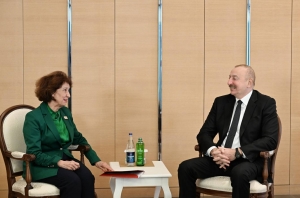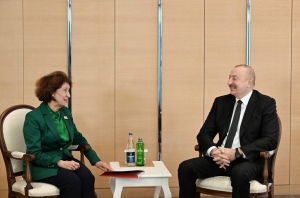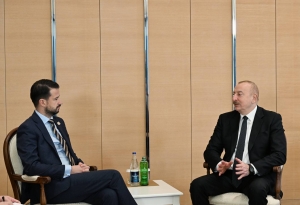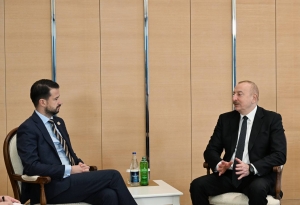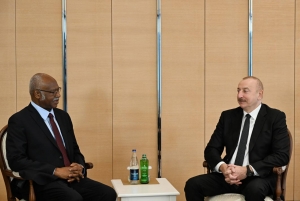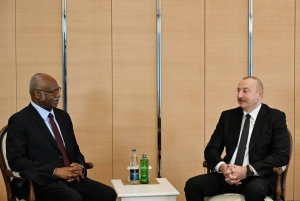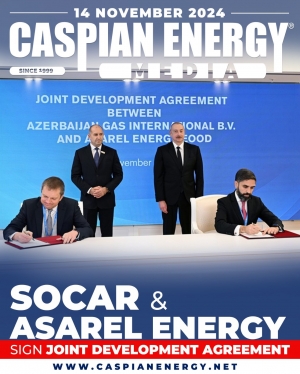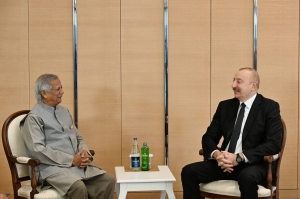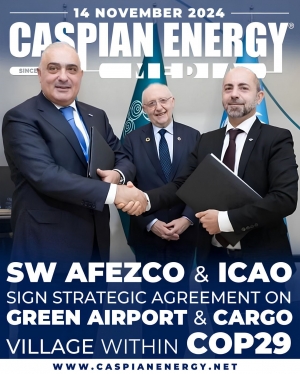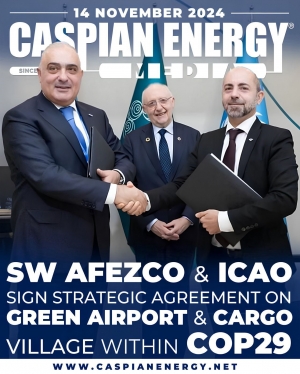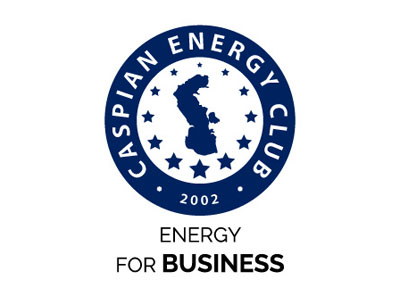Super User
Ilham Aliyev met with President of North Macedonia
On November 14, Ilham Aliyev, President of the Republic of Azerbaijan, met with Gordana Siljanovska Davkova, President of the Republic of North Macedonia.
Gordana Siljanovska Davkova commended the excellent organization of COP29 and noted the interesting presentation on Azerbaijani culture during the opening ceremony. She also expressed her support for cultural diplomacy and conveyed her pleasure in getting to know Azerbaijani culture. Additionally, she highlighted the broad opportunities for cooperation with Azerbaijan.
“Caspian Energy Media” reports with reference to the official website of the President of Azerbaijan.
Ильхам Алиев встретился с Президентом Северной Македонии
14 ноября Президент Азербайджанской Республики Ильхам Алиев встретился с Президентом Республики Северная Македония Горданой Силяновской-Давковой.
Подчеркнув, что COP29 организована на высоком уровне, Гордана Силяновская-Давкова сказала, что на церемонии открытия мероприятия была представлена интересная презентация об азербайджанской культуре. Отметив, что она поддерживает культурную дипломатию, высокая гостья выразила удовлетворение ознакомлением с культурой Азербайджана. Она подчеркнула наличие широких возможностей для сотрудничества с Азербайджаном.
Об этом сообщает “Caspian Energy Media” со ссылкой на официальный сайт главы Азербайджанского государства.
Ильхам Алиев встретился с Президентом Монтенегро
14 ноября Президент Азербайджанской Республики Ильхам Алиев встретился с Президентом Монтенегро Яковом Милатовичем.
Яков Милатович поздравил главу нашего государства с проведением COP29 на высоком уровне. Он подчеркнул, что COP29 можно назвать успешным мероприятием. Президент Монтенегро сказал, что в COP29 принимают участие более 80 глав государств и правительств, одновременно это мероприятие демонстрирует миру достижения Азербайджана.
Об этом сообщает “Caspian Energy Media” со ссылкой на официальный сайт главы Азербайджанского государства.
Ilham Aliyev met with President of Montenegro
On November 14, Ilham Aliyev, President of the Republic of Azerbaijan, met with Jakov Milatović, President of Montenegro.
Jakov Milatović congratulated the Azerbaijani President on the successful organization of COP29, describing it as a successful event. He highlighted that more than 80 heads of state and government participated in COP29, noting that the event also showcased Azerbaijan's achievements to the world.
“Caspian Energy Media” reports with reference to the official website of the President of Azerbaijan.
Ilham Aliyev met with President of 79th Session of UN General Assembly
On November 14, Ilham Aliyev, President of the Republic of Azerbaijan, met with Philemon Yang, President of the 79th Session of the UN General Assembly. Emphasizing the high-level relations between the United Nations and Azerbaijan, Philemon Yang underscored that Azerbaijan remains fully committed to the UN Charter.
“Caspian Energy Media” reports with reference to the official website of the President of Azerbaijan.
Ильхам Алиев встретился с председателем 79-й сессии Генеральной Ассамблеи ООН
14 ноября Президент Азербайджанской Республики Ильхам Алиев встретился с председателем 79-й сессии Генеральной Ассамблеи ООН Филемоном Янгом. Отметив, что отношения ООН с Азербайджаном находятся на очень высоком уровне, Филемон Янг подчеркнул, что наша страна полностью привержена Уставу ООН.
Об этом сообщает “Caspian Energy Media” со ссылкой на официальный сайт главы Азербайджанского государства.
Подписано "Совместное соглашение о развитии между SOCAR и Asarel Energy"
13 ноября Президент Азербайджанской Республики Ильхам Алиев встретился с Президентом Республики Болгария Руменом Радевым.
Сначала с участием президентов Азербайджана и Болгарии состоялось подписание «Совместного соглашения о развитии между SOCAR и Asarel Energy».
Президент Ильхам Алиев подчеркнул на встрече значение подписанного документа, коснулся его вклада в укрепление нашего сотрудничества.
Об этом сообщает “Caspian Energy Media” со ссылкой на официальный сайт главы Азербайджанского государства.
Ilham Aliyev met with Chief Adviser to the Interim Government of Bangladesh
On November 14, Ilham Aliyev, President of the Republic of Azerbaijan, met with Muhammad Yunus, Chief Adviser to the Interim Government of the People's Republic of Bangladesh.
Muhammad Yunus fondly recalled his previous visit to Azerbaijan, highlighting his collaboration with the Nizami Ganjavi International Center and active participation in its events.
He praised Azerbaijan for becoming a venue for significant international events and congratulated the head of state on the successful organization of COP29 within a short timeframe.
“Caspian Energy Media” reports with reference to the official website of the President of Azerbaijan.
“Silk Way Alat Free Economic Zone” и ИКАО подписали стратегическое соглашение по созданию зеленого аэропорта и грузовой деревни
В рамках конференции COP29 компания Silk Way Alat Free Economic Zone (SW AFEZCO) и Международная организация гражданской авиации (ИКАО) подписали стратегическое соглашение, что стало знаковым событием на пути к развитию устойчивой авиации. Сотрудничество, направленное на продвижение устойчивых экологических целей как ИКАО, так и Азербайджанской Республики, воплощает общее видение и совместную приверженность созданию сертифицированного зеленого аэропорта и грузовой деревни в свободной экономической зоне Алят (СЭЗ Алят).
Об этом сообщает “Caspian Energy Media” со ссылкой на Silk Way Group.
“Silk Way Alat Free Economic Zone” şirkəti və ICAO arasında yaşıl hava limanı və karqo kəndinə dair strateji razılaşma imzalanıb
“Silk Way Alat Free Economic Zone” şirkəti (SW AFEZCO) və Beynəlxalq Mülki Aviasiya Təşkilatı (ICAO) COP29 çərçivəsində dayanıqlı aviasiyanın inkişafı istiqamətində mühüm bir addım olan strateji razılaşma imzalayıb. Ələt Azad İqtisadi Zonasında sertifikatlaşdırılmış yaşıl hava limanı və karqo kəndinin yaradılması üçün ortaq baxış və ümumi öhdəliyi təcəssüm etdirən bu əməkdaşlıq həm ICAO-nun, həm də Azərbaycan Respublikasının ekoloji dayanıqlılıq məqsədlərinə cavab verir.
Bu əməkdaşlıq həm milli qanunvericiliyə, həm də beynəlxalq ətraf mühitin mühafizəsi standartlarına əsaslanacaq ekoloji cəhətdən dayanıqlı hava limanı əməliyyatlarını inkişaf etdirmək məqsədi daşıyır. Əsas diqqət mərkəzində olan sahələrə “Yaşıl Hava Limanı” sertifikatına nail olmaq üçün ICAO-nun texniki təlimatı, sənayedə aparıcı ekoloji təcrübələrin inteqrasiyası və Ələt Azad İqtisadi Zonasının dayanıqlı hava limanı əməliyyatları üçün etalon kimi yaradılması üçün innovasiyalar daxildir.
Bu barədə “Caspian Energy Media” Silk Way Group-a istinadən xəbər verir.




